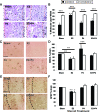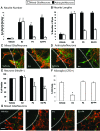Progesterone influence on neurite outgrowth involves microglia
- PMID: 18772232
- PMCID: PMC2630906
- DOI: 10.1210/en.2008-0988
Progesterone influence on neurite outgrowth involves microglia
Abstract
Progesterone (P4) antagonizes estradiol (E2) in synaptic remodeling in the hippocampus during the rat estrous cycle. To further understand how P4 modulates synaptic plasticity, we used entorhinal cortex lesions, which induce E2-dependent neurite sprouting in the hippocampus. In young ovariectomized rats, the E2-dependent entorhinal cortex lesion-induced sprouting was attenuated by concurrent treatment with P4 and E2. Microglial activation also showed the E2-P4 antagonism. These findings extend reports on the estrous cycle synaptic remodeling without lesions by showing the P4-E2 antagonism during simultaneous treatment with both E2 and P4. Glial mechanisms were analyzed with the wounding-in-a-dish model of cocultured glia and embryonic d-18 cortical neurons from rat. In cocultures of mixed glia (astrocytes plus 30% microglia), P4 antagonized the E2-dependent neurite outgrowth (number and length) and neuron viability in the presence of E2, as observed in vivo. However, removal of microglia (astrocyte-neuron coculture) abolished the antagonism of E2 by P4 on neuron sprouting. The P4 receptor antagonists ORG-31710 and RU-486 blocked the antagonism of P4 on E2-dependent sprouting. These findings suggest a new role for microglia in P4 antagonism of E2 in neuronal plasticity and show its dependence on progesterone receptors. These findings are also relevant to the inclusion of progestins in hormone therapy, which is controversial in relation to cognitive declines during aging and in Alzheimer's disease.
Figures




Similar articles
-
Differential responses of progesterone receptor membrane component-1 (Pgrmc1) and the classical progesterone receptor (Pgr) to 17β-estradiol and progesterone in hippocampal subregions that support synaptic remodeling and neurogenesis.Endocrinology. 2012 Feb;153(2):759-69. doi: 10.1210/en.2011-1699. Epub 2011 Dec 6. Endocrinology. 2012. PMID: 22147012 Free PMC article.
-
Progesterone antagonism of neurite outgrowth depends on microglial activation via Pgrmc1/S2R.Endocrinology. 2013 Jul;154(7):2468-80. doi: 10.1210/en.2012-2109. Epub 2013 May 7. Endocrinology. 2013. PMID: 23653459 Free PMC article.
-
Impact of continuous versus discontinuous progesterone on estradiol regulation of neuron viability and sprouting after entorhinal cortex lesion in female rats.Endocrinology. 2015 Mar;156(3):1091-9. doi: 10.1210/en.2014-1216. Epub 2014 Dec 16. Endocrinology. 2015. PMID: 25514084 Free PMC article.
-
Progesterone reverses the estradiol-induced decrease in tyrosine hydroxylase mRNA levels in the arcuate nucleus.Neuroendocrinology. 1993 Nov;58(5):501-10. doi: 10.1159/000126583. Neuroendocrinology. 1993. PMID: 7906870
-
Progesterone-estrogen interactions in synaptic plasticity and neuroprotection.Neuroscience. 2013 Jun 3;239:280-94. doi: 10.1016/j.neuroscience.2012.10.051. Epub 2012 Nov 7. Neuroscience. 2013. PMID: 23142339 Free PMC article. Review.
Cited by
-
Interictal spike frequency varies with ovarian cycle stage in a rat model of epilepsy.Exp Neurol. 2015 Jul;269:102-19. doi: 10.1016/j.expneurol.2015.04.003. Epub 2015 Apr 10. Exp Neurol. 2015. PMID: 25864929 Free PMC article.
-
Sex and Region-Specific Differences in Microglial Morphology and Function Across Development.Neuroglia. 2025 Mar;6(1):2. doi: 10.3390/neuroglia6010002. Epub 2025 Jan 4. Neuroglia. 2025. PMID: 40181886 Free PMC article.
-
Differential responses of progesterone receptor membrane component-1 (Pgrmc1) and the classical progesterone receptor (Pgr) to 17β-estradiol and progesterone in hippocampal subregions that support synaptic remodeling and neurogenesis.Endocrinology. 2012 Feb;153(2):759-69. doi: 10.1210/en.2011-1699. Epub 2011 Dec 6. Endocrinology. 2012. PMID: 22147012 Free PMC article.
-
Sex and the development of Alzheimer's disease.J Neurosci Res. 2017 Jan 2;95(1-2):671-680. doi: 10.1002/jnr.23827. J Neurosci Res. 2017. PMID: 27870425 Free PMC article. Review.
-
Sex Hormones Regulate Cytoskeletal Proteins Involved in Brain Plasticity.Front Psychiatry. 2015 Nov 20;6:165. doi: 10.3389/fpsyt.2015.00165. eCollection 2015. Front Psychiatry. 2015. PMID: 26635640 Free PMC article. Review.
References
-
- Woolley CS, McEwen BS 1993 Roles of estradiol and progesterone in regulation of hippocampal dendritic spine density during the estrous cycle in the rat. J Comp Neurol 336:293–306 - PubMed
-
- Choi JM, Romeo RD, Brake WG, Bethea CL, Rosenwaks Z, McEwen BS 2003 Estradiol increases pre- and post-synaptic proteins in the CA1 regions of the hippocampus in female rhesus macaques (Macaca mulatta). Endocrinology 144:4734–4738 - PubMed
-
- McEwen BS 2002 Estrogens effects on the brain: multiple sites and molecular mechanisms. J Appl Physiol 91:2785–2801 - PubMed
-
- Chen E, Nilsen J, Brinton RD 2006 Dose and temporal pattern of estrogen exposure determines neuroprotective outcome in hippocampal neurons: therapeutic implications. Endocrinology 147:5303–5313 - PubMed

